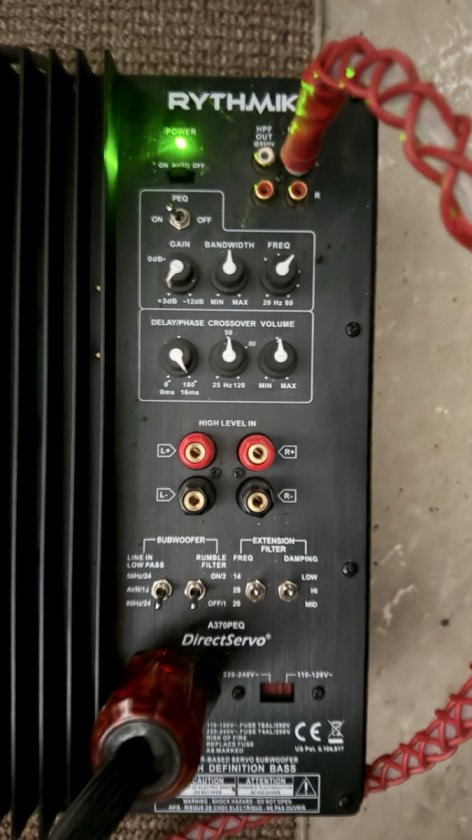This may be of interest to / helpful to some, regardless of whether you hear this speaker.
So I was wandering around back near the subs and looked down and thought "Oh, let's take a picture of those settings..."
These are the sub settings for Danny's pair of Triple OB subs, playing with the "Allie" speakers.
So we started talking about what was going on for the entire setup.
The Alpha One speakers were being crossed at ~80Hz as I recall - via the preamp.
Look at the settings on the sub... the lower left switch is on 80Hz/24db Low Pass. Ported speakers roll off at 24Hz slope and that 80Hz plays ball too...
Me: "Danny, I see it's at 180 degrees..."
Danny: "Well, the M130 woofer is wired out of phase, so the sub is set to 180 degrees to pair with that output".
Me: "Why not bring the subs up next to the speakers... why do I often see them offset to the rear?"
Danny: "At that low frequency, the wavelengths are so long that a few feet does not cause enough phase rotation for it to make a difference... so you can place them there and keep things clear for the main speakers to be better optimized."
These settings may help others think thru what is going on in their own setups - and it shows that this is a "system".
I don't like the idea of putting a cap in front of the signal to roll it off, but Danny rightly pointed out there are caps in a lot of things in the chain... not to mention the speakers. Danny talks about "less mass", etc for connections... getting caps out of the signal path would be great, but sometimes that cap allows the speaker to do things it can't do otherwise - the "negative" is actually a "net positive".
I.e., Results matter.
We talked about woofers that play lower "Why not use a woofer that plays lower so you don't have to roll it off, for instance, like a Scan Speak 8545?"
"Danny... why not use one of the 8" drivers like in my Duette speakers and pair it with the LGK so it plays much deeper?"
Danny agreed, the speaker would play lower with that and other woofers, but here's the thing... the M130 is faster, and if you keep it in the range where it's Happy, it will have speed in the mid-bass that helps it keep up with the magic from the LGK - and leave the heavy lifting for subs.
I think the bottom line is along these lines, especially for this pair of speakers... "Use an extremely high quality cap for the high pass so it's ultra fast, and help it blend perfectly to the sub... the result is superior sound such that you will GET OVER a cap being in the signal path (notwithstanding all of the caps elsewhere)."

After hearing the detail / performance - I am just going to have to get over the "high pass thing" in certain cases - because the result is just plain better.
Danny is right... but I had to hear it for myself. That's just the way it is.
